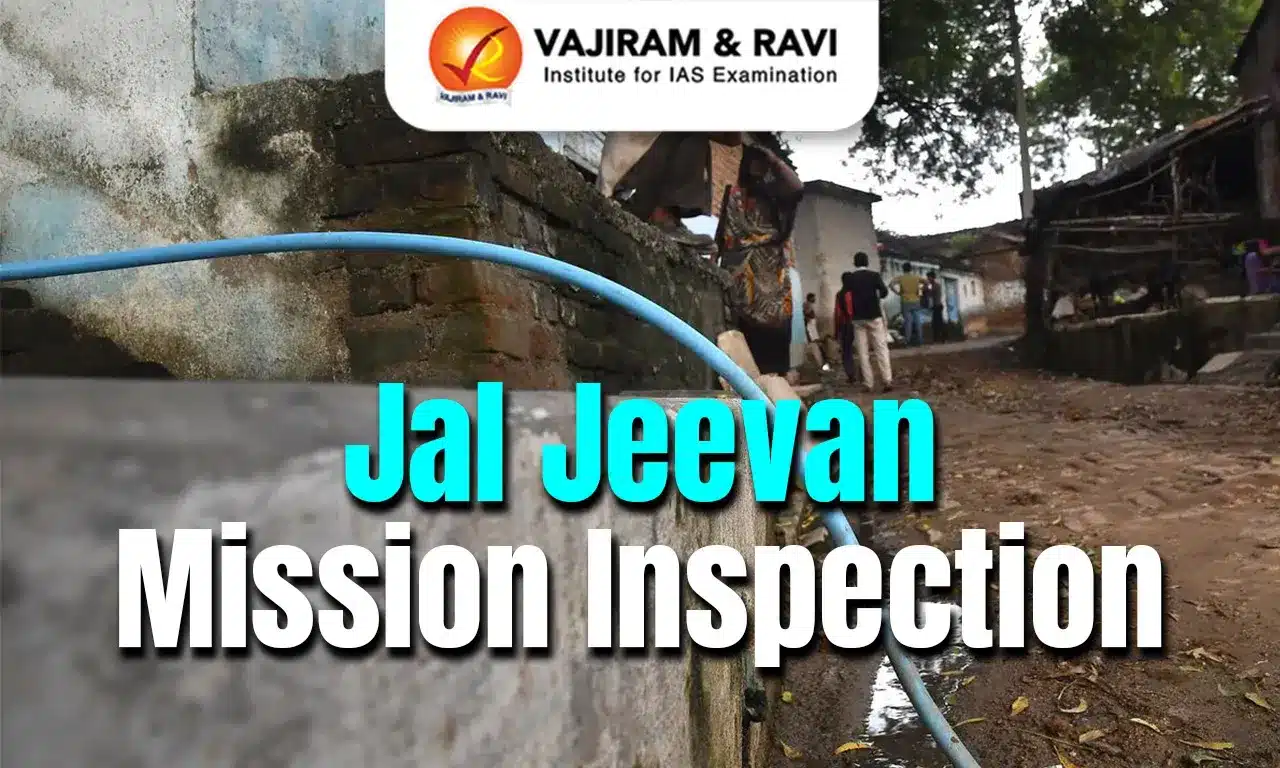Jal Jeevan Mission Latest News
- The Central Government has decided to send 100 teams of Central Nodal Officers for “ground inspection” of the Jal Jeevan Mission schemes across the country.
- The move follows a meeting chaired by the Cabinet Secretary recently to review the mission’s schemes.
Introduction
- Jal Jeevan Mission is a Centrally Sponsored Scheme, launched by the Ministry of Jal Shakti on 15th August, 2019.
- Objective: To provide to all households in rural India safe and adequate water through individual household tap connections by 2024.
- The Jal Jeevan Mission is based on a community approach to water.
- According to the government, the mission includes Information, Education and Communication as key components.
- The mission is meant to create a people’s movement for water, making it everyone’s priority.
- Institutional Mechanism under JJM
Jal Jeevan Mission: Scope and Achievements
- The original budgetary outlay of the scheme stood at Rs. 3.6 lakh crore.
- However, with new approvals and revised cost estimates, the total projected expenditure has more than doubled to Rs. 8.29 lakh crore as of 2025.
- Key achievements include:
- Coverage expanded to over 14 crore rural households, up from 3.2 crore in 2019.
- Over 6.4 lakh water supply schemes have been sanctioned across the country.
- Emphasis on source sustainability, village-level water quality monitoring, and convergence with MGNREGA and SBM (Gramin).
- However, disparities remain among states in execution speed and quality, and some regions have reported challenges in water source availability and community mobilization.
Challenges Facing the Mission
- Escalating Costs:
- The cost per tap connection has reportedly increased from Rs. 30,000 to Rs. 1,37,500 in some areas. This sharp rise has prompted scrutiny from the Ministry of Finance and the Expenditure Finance Committee (EFC).
- Slow Implementation in Certain States:
- While some states like Gujarat and Telangana have performed well, others are lagging in infrastructure setup, quality checks, and timely utilization of funds.
- Quality of Work:
- Reports from rural areas indicate that in some cases, pipeline infrastructure is substandard, or connections are functional only intermittently.
- Monitoring and Evaluation Gaps:
- The vast scale of the project has made it difficult to ensure real-time auditing and third-party verifications, leading to lapses.
News Summary
- In light of the mounting fiscal and operational concerns, the Government of India has decided to send 100 teams of nodal officers to conduct ground-level inspections of JJM schemes across 135 districts in 29 states and Union Territories.
- Key Details of the Review Initiative:
- The review decision follows a Cabinet Secretary-led meeting on May 8, 2025.
- The Department of Personnel and Training (DoPT) has nominated 99 nodal officers to inspect 183 water supply schemes, many of which cost over Rs. 1,000 crore.
- These schemes collectively account for Rs. 1.5 lakh crore, or 20% of the total JJM outlay.
- Reason for Cost Overrun:
- The Jal Shakti Ministry had sought Rs. 2.79 lakh crore in additional central funding to meet the escalated costs for completing the scheme by 2028.
- A standardized questionnaire has been prepared for these inspection teams, which will evaluate both the cost and quality of execution.
- A training session for the officers was scheduled on May 23 to familiarize them with inspection protocols.
Jal Jeevan Mission Inspection FAQs
Q1. Why is the Government sending 100 teams to inspect Jal Jeevan Mission schemes?
Ans. To assess cost escalation, quality of work, and implementation across various states.
Q2. How many schemes are being inspected under this initiative?
Ans. 183 schemes across 135 districts in 29 states and UTs.
Q3. What is the cost implication of the selected schemes?
Ans. These schemes have a cumulative cost of ₹1.5 lakh crore, or 20% of total approved costs.
Q4. What was the original and revised outlay of Jal Jeevan Mission?
Ans. The original outlay was ₹3.6 lakh crore; the revised estimate is ₹8.29 lakh crore.
Q5. Why did the Finance Ministry approve only half the requested additional funding?
Ans. Due to concerns over inflated work orders and lack of justifications for cost hikes.
Source: IE
Last updated on June, 2025
→ UPSC Notification 2025 was released on 22nd January 2025.
→ UPSC Prelims Result 2025 is out now for the CSE held on 25 May 2025.
→ UPSC Prelims Question Paper 2025 and Unofficial Prelims Answer Key 2025 are available now.
→ UPSC Calendar 2026 is released on 15th May, 2025.
→ The UPSC Vacancy 2025 were released 1129, out of which 979 were for UPSC CSE and remaining 150 are for UPSC IFoS.
→ UPSC Mains 2025 will be conducted on 22nd August 2025.
→ UPSC Prelims 2026 will be conducted on 24th May, 2026 & UPSC Mains 2026 will be conducted on 21st August 2026.
→ The UPSC Selection Process is of 3 stages-Prelims, Mains and Interview.
→ UPSC Result 2024 is released with latest UPSC Marksheet 2024. Check Now!
→ UPSC Toppers List 2024 is released now. Shakti Dubey is UPSC AIR 1 2024 Topper.
→ Also check Best IAS Coaching in Delhi
Tags: jal jeevan mission mains articles upsc current affairs upsc mains current affairs
























